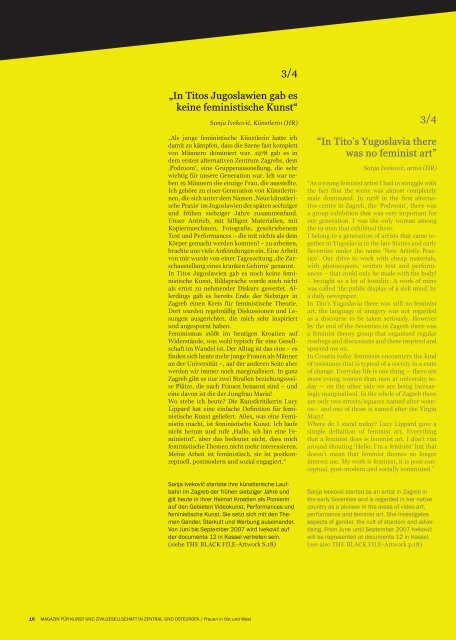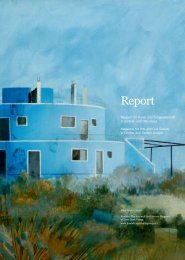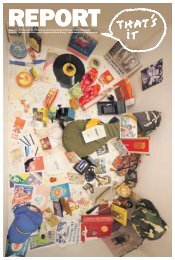You also want an ePaper? Increase the reach of your titles
YUMPU automatically turns print PDFs into web optimized ePapers that Google loves.
16 MAGAZIN FÜR KUNST UND ZIVILGESELLSCHAFT IN ZENTRAL- UND OSTEUROPA / <strong>Frauen</strong> in Ost und West<br />
3/4<br />
„In Titos Jugoslawien gab es<br />
keine feministische Kunst“<br />
Sanja Iveković, Künstlerin (HR)<br />
„Als junge feministische Künstlerin hatte ich<br />
damit zu kämpfen, dass die Szene fast komplett<br />
von Männern dominiert war. 1978 gab es in<br />
dem ersten alternativen Zentrum Zagrebs, dem<br />
,Podroom‘, eine Gruppenausstellung, die sehr<br />
wichtig für unsere Generation war. Ich war neben<br />
19 Männern die einzige Frau, die ausstellte.<br />
Ich gehöre zu einer Generation von Künstlerinnen,<br />
die sich unter dem Namen ,Neue künstlerische<br />
Praxis‘ im Jugoslawien der späten sechziger<br />
und frühen siebziger Jahre zusammenfand.<br />
Unser Antrieb, mit billigen Materialien, mit<br />
Kopiermaschinen, Fotografie, geschriebenem<br />
Text und Performances – die mit nichts als dem<br />
Körper gemacht werden konnten! – zu arbeiten,<br />
brachte uns viele Anfeindungen ein. Eine Arbeit<br />
von mir wurde von einer Tageszeitung ,die Zurschaustellung<br />
eines kranken Gehirns‘ genannt.<br />
In Titos Jugoslawien gab es noch keine feministische<br />
Kunst, Bildsprache wurde noch nicht<br />
als ernst zu nehmender Diskurs gewertet. Allerdings<br />
gab es bereits Ende der Siebziger in<br />
Zagreb einen Kreis für feministische Theorie.<br />
Dort wurden regelmäßig Diskussionen und Lesungen<br />
ausgerichtet, die mich sehr inspiriert<br />
und angespornt haben.<br />
Feminismus stößt im heutigen Kroatien auf<br />
Widerstände, was wohl typisch für eine Gesellschaft<br />
im Wandel ist. Der Alltag ist das eine – es<br />
finden sich heute mehr junge <strong>Frauen</strong> als Männer<br />
an der Universität –, auf der anderen Seite aber<br />
werden wir immer noch marginalisiert. In ganz<br />
Zagreb gibt es nur zwei Straßen beziehungsweise<br />
Plätze, die nach <strong>Frauen</strong> benannt sind – und<br />
eine davon ist die der Jungfrau Maria!<br />
Wo stehe ich heute? Die Kunstkritikerin Lucy<br />
Lippard hat eine einfache Definition für feministische<br />
Kunst geliefert: Alles, was eine Feministin<br />
macht, ist feministische Kunst. Ich laufe<br />
nicht herum und rufe ,Hallo, ich bin eine Feministin!‘,<br />
aber das bedeutet nicht, dass mich<br />
feministische Themen nicht mehr interessieren.<br />
Meine Arbeit ist feministisch, sie ist postkonzeptuell,<br />
postmodern und sozial engagiert.“<br />
Sanja Iveković startete ihre künstlerische Laufbahn<br />
im Zagreb der frühen siebziger Jahre und<br />
gilt heute in ihrer Heimat Kroatien als Pionierin<br />
auf den Gebieten Videokunst, Performances und<br />
feministische Kunst. Sie setzt sich mit den Themen<br />
Gender, Starkult und Werbung auseinander.<br />
Von Juni bis September 2007 wird Iveković auf<br />
der documenta 12 in Kassel vertreten sein.<br />
(siehe THE BLACK FILE-Artwork S.18)<br />
3/4<br />
“In Tito’s Yugoslavia there<br />
was no feminist art”<br />
Sanja Iveković, artist (HR)<br />
“As a young feminist artist I had to struggle with<br />
the fact that the scene was almost completely<br />
male dominated. In 1978 in the first alternative<br />
centre in Zagreb, the ‘Podroom’, there was<br />
a group exhibition that was very important for<br />
our generation. I was the only woman among<br />
the 19 men that exhibited there.<br />
I belong to a generation of artists that came together<br />
in Yugoslavia in the late Sixties and early<br />
Seventies under the name ‘New Artistic Practice’.<br />
Our drive to work with cheap materials,<br />
with photocopiers, written text and performances<br />
– that could only be made with the body!<br />
– brought us a lot of hostility. A work of mine<br />
was called ‘the public display of a sick mind’ by<br />
a daily newspaper.<br />
In Tito’s Yugoslavia there was still no feminist<br />
art, the language of imagery was not regarded<br />
as a discourse to be taken seriously. However<br />
by the end of the Seventies in Zagreb there was<br />
a feminist theory group that organised regular<br />
readings and discussions and these inspired and<br />
spurred me on.<br />
In Croatia today feminism encounters the kind<br />
of resistance that is typical of a society in a state<br />
of change. Everyday life is one thing — there are<br />
more young women than men at university today<br />
— on the other side we are being increasingly<br />
marginalized. In the whole of Zagreb there<br />
are only two streets/squares named after women—<br />
and one of those is named after the Virgin<br />
Mary!<br />
Where do I stand today? Lucy Lippard gave a<br />
simple definition of feminist art. Everything<br />
that a feminist does is feminist art. I don’t run<br />
around shouting ‘Hello, I’m a feminist’ but that<br />
doesn’t mean that feminist themes no longer<br />
interest me. My work is feminist, it is post-conceptual,<br />
post-modern and socially committed.”<br />
Sanja Iveković started as an artist in Zagreb in<br />
the early Seventies and is regarded in her native<br />
country as a pioneer in the areas of video art,<br />
performance and feminist art. She investigates<br />
aspects of gender, the cult of stardom and advertising.<br />
From June until September 2007 Iveković<br />
will be represented at documenta 12 in Kassel.<br />
(see also THE BLACK FILE-Artwork p.18)




